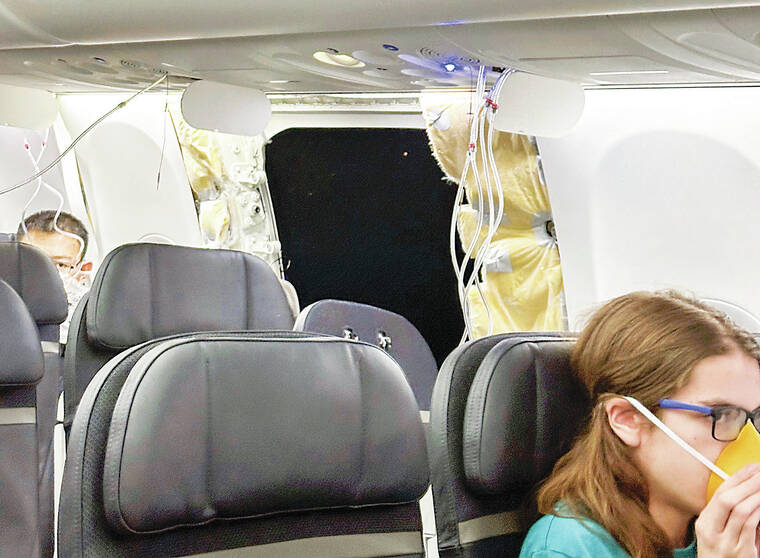Twisted metal, rushing wind: A narrowly avoided disaster as jet’s wall rips away at 3 miles high
PORTLAND, Ore. — The loud “boom” was startling enough, and the roaring wind that immediately filled the airline cabin left Kelly Bartlett unnerved. Still, it wasn’t until a shaken teenager, shirtless and scratched, slid into the seat next to her that she realized just how close disaster had come.
A section of the Boeing 737 Max 9’s fuselage just three rows away had blown out — at 3 miles (4.8 kilometers) high — creating a vacuum that twisted the metal of the seats nearby, and snatched cellphones, headsets and even the shirt off the teenager’s back.
ADVERTISING
“We knew something was wrong,” Bartlett told The Associated Press on Monday. “We didn’t know what. We didn’t know how serious. We didn’t know if it meant we were going to crash.”
The first six minutes of Alaska Airlines flight 1282 from Portland to Southern California’s Ontario International Airport on Friday had been routine, the Boeing 737 Max 9 about halfway to its cruising altitude and traveling at more than 400 mph (640 kph).
Flight attendants had just told the 171 passengers that they could resume using electronic devices — in airplane mode, of course — when it happened.
Then suddenly a 2-foot-by-4-foot (61-centimeter-by-122-centimeter) piece of fuselage covering an unoperational emergency exit behind the left wing blew out. Only seven seats on the flight were unoccupied, and as fate would have it, these included the two seats closest to the blown-out hole.
The oxygen masks dropped immediately, and Bartlett saw a flight attendant walking down the aisle toward the affected row, leaning forward as if facing a stiff wind. Then flight attendants began moving passengers from the area where the blowout occurred.
Among them was the teenage boy moved next to Bartlett.
“His shirt got sucked off of his body when the panel blew out because of the pressure, and it was his seatbelt that kept him in his seat and saved his life. And there he was next to me,” she said, adding that his mother was reseated elsewhere.
“We had our masks on, and the plane was really loud so we couldn’t talk. But I had a … notes app on my phone that I was typing on. So I typed to him and I asked him if he was hurt,” Bartlett said. “I just couldn’t believe he was sitting there and what he must have gone through, what he must have been feeling at the time.”
She said the boy typed back that he was OK, but a bit scratched, adding “that was unbelievable” and “thank you for your kindness.”
The pilots and flight attendants have not made public statements and their names have not been released, but in interviews with National Transportation Safety Board investigators they described how their training kicked in. The pilots focused on getting the plane quickly back to Portland and the flight attendants on keeping the passengers safe and as calm as possible.
“The actions of the flight crew were really incredible,” NTSB Chair Jennifer Homendy said at a Sunday night news conference. She described the scene inside the cabin during those first seconds as “chaos, very loud between the air and everything going on around them and it was very violent.”
Inside the cockpit, the pilot and co-pilot donned their oxygen masks and opened their microphone, but “communication was a serious issue” between them and the flight attendants because of the noise, Homendy said. The pilots retrieved an emergency handbook kept secure next to the captain’s seat.
The co-pilot contacted air traffic controllers, declaring an emergency and saying the plane needed to immediately descend to 10,000 feet (3,048 meters), the altitude where there is enough oxygen for everyone onboard to breathe.
“We need to turn back to Portland,” she said in a calm voice that she maintained throughout the landing.


